San Antonio, Texas is observing 300 years since its founding in 1718 by Spain through its network of Franciscan friars. Tricentennial celebrations, such as lectures, musical programs, and educational events, are taking place all year long around town.
But since its opening at the San Antonio Museum of Art in February, a blockbuster art exhibit has been drawing crowds from near and far. One reason is that “San Antonio 1718: Art from Viceregal Mexico,” focuses exclusively on San Antonio’s first 100 years.
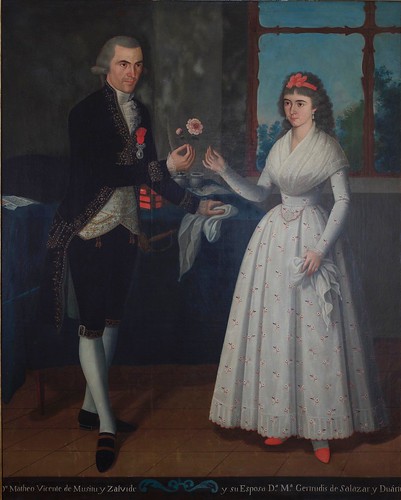
José Mariano Lara (New Spain, born mid-18th century). Matheo Vicente de Musitu y Zalvide and his Wife (Matheo Vicente de Musitu y Zalvide y su esposa), 1799. Oil on canvas, h. 88 ½ in. (225 cm); w. 72 ½ in. (184 cm). Colección Banco Nacional de México. Mexico City.
Another reason for the big draw is that this exhibition, which closes May 13, features artwork not displayed before in the US. Narrative paintings, portraits, sculptures, and religious and decorative objects numbering more than 100 chronicle the lives of Texas’ earliest settlers and Spanish citizens.
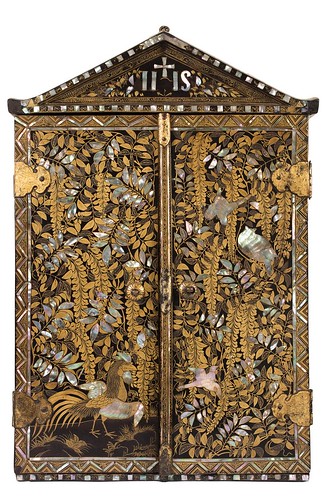
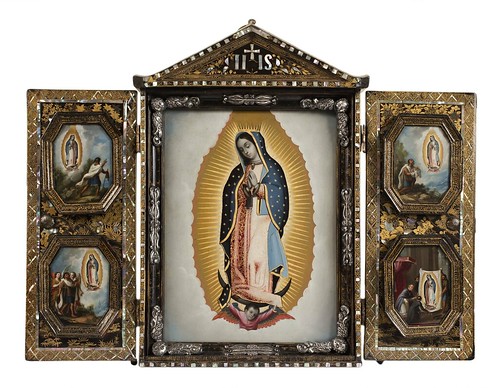
Artist unknown, Japan. Traveling Altar with the Virgin of Guadalupe with the Four Apparitions (Altar de Viaje con la Virgen de Guadalupe y las Cuatro Apariciones), 16th century. Lacquered wood decorated in gold, with mother-of-pearl applications
This is no ordinary exhibition. For one, more than ninety percent of the artworks are on loan directly from Mexico in collaboration with the Instituto Nacional de Antropologia e Historia. The artworks were sourced from 30 public institutions and private collections in Mexico and the US.
The goal in focusing on San Antonio’s first 100 years is to put it in the context of its original founding as a city on the edge of what was then known as “New Spain” and directly under the vast Spanish empire. Mexico’s independence from Spain in 1821 shifted the area to Mexican rule until the Texas revolution.

Artist unknown, New Spain. Sister María Antonia of the Immaculate Conception (Sor María Antonia de la Purísima Concepción), late 18th century. Oil on canvas, h. 47 in. (120 cm); w. 37 in. (95 cm). Museo Nacional del Virreinato,, 168030, Secretaría de Cultura, INAH, MX. Tepotzotlán, México. Photography by Francisco Kochen
Another reason this is one of the most extraordinary exhibitions Bexar County, the city of San Antonio, and Texas has ever hosted is that this art exhibition was five long years and countless hours in the making.
“When I first started doing research on this project, I found out that there just wasn’t any artwork here that was representative of the city’s first 100 years,” said Marion Oettinger, SAMA’s Latin American Art curator.
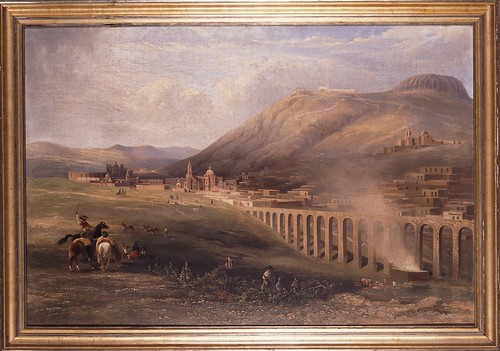
Vista de Zacatecas tomada desde el acueducto
Oettinger told a crowd of museum visitors recently that aside from San Antonio’s five historic missions, which earned World Heritage Designation from UNESCO in 2015, few artworks were recovered from the missions.

He compared his research to a five-year treasure hunt that took him on journeys to several cities in Mexico, including Mexico City, Queretaro and Zacatecas. In the process, Oettinger learned that the Spanish had a unique caste system.

Ignacio María Barreda (New Spain, late 18th century). María Manuela Esquivel y Serruto, 1794. Oil on canvas, h. 29 in. (81 cm); w. 37 in. (61 cm). Museo Nacional de Historia, 10-233550, Secretaría de Cultura, INAH, MX. Mexico City. Photography by Francisco Kochen
This hierarchical system of castes, focusing on social class, lineage and bloodline, is reflected in many of the lovely portraits that grace the walls of the art gallery. The exhibition leads off with a “People and Places” section.
Here, visitors get an idea of the different classes of people who lived and worked in and around the city. They also learn about intermarriages between Spaniards and Indians, which produced most of the “mestizo” population of Mexico and Texas. To a lesser extent, the union between the handful of African slaves brought to Mexico gave rise to the word “mulatto,” a word the Spanish used to describe the union between a Spaniard or European and an African or someone from African lineage.

Jose de Páez (New Spain, 1720-1790). De Español e India produce Mestizo, from series of Mexican Castes, ca. 1780. Oil on canvas; h. 36 in. (91 cm); w. 41 in. (104.5 cm). Private Collection. Photography by Minerva Morales
The second section is titled “The Cycle of Life” and depicts Spanish citizens in their various situations from birth to death. Visitors will see men, women and children reflected in a wealth of portraiture. One of the best illustrations is a large 18th century oil on canvas titled the “Allegory of the Stages of Man.”
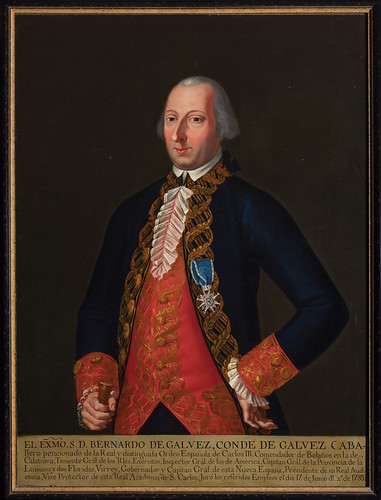
José Germán de Alfaro (New Spain, active 1779-1786). Count Bernardo de Gálvez (Conde Bernardo de Gálvez), ca. 1785. Oil on canvas, h. 44 in. (112 cm); w. 33 ½ in. (84 cm). Museo Nacional de Historia, 10-230126, Secretaría de Cultura, INAH, MX. Mexico City. Photography by Francisco Kochen
The third and final section is simply called “The Church,” which highlights the influence of the Roman Catholic Church. The Spanish friars, who were trained in Queretaro, Mexico, prior to assuming their duties, were tasked with evangelizing the native Indian tribes that lived in Texas.
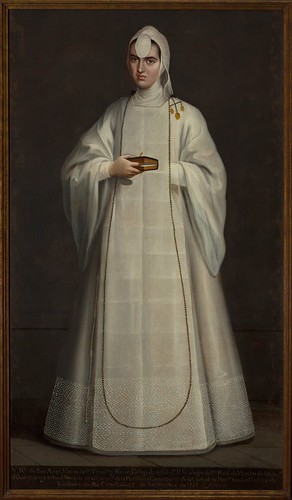
Artist unknown, New Spain. Sor Ana María de San Francisco y Neve, ca. 1760. Oil on canvas, h. 71 in. (180 cm); w. 47 in. (120 cm). Propiedad de la Nación Mexicana. Secretaría de Cultura. Dirección General de Sitios y Monumentos del Patrimonio Cultural. Acervo del Templo de Santa Rosa de Viterbo, Querétaro, México. Photography by Francisco Kochen
Early settlers, soldiers, and Indians, who lived in the missions and converted to Catholicism, became intimately familiar with religious images, revered saints, and Catholic customs. This resulted in a treasure trove of representative artwork.
Some of those on display include paintings depicting angels, The Virgin of the Rosary, the procession of Saint John. There are also candlesticks, a missal stand, and intricately carved trunks produced during the Spanish colonial era.
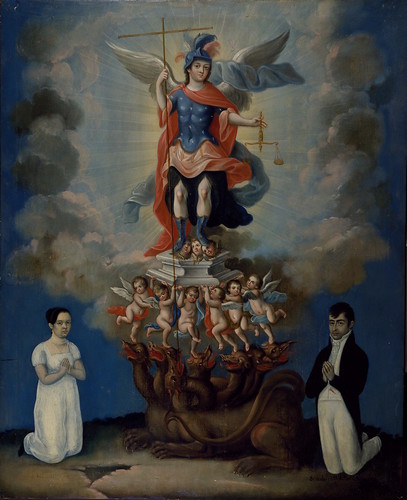
Retrato de un matrimonio a devoción de san Miguel Arcángel
Many of the artists featured in the “San Antonio 1718: Art from Viceregal Mexico” represent New Spain’s most talented 18th century artists, such as Cristobal de Villalpando (1649-1714) Miguel Cabrera (1695-1768), and Jose de Paez (1720-1790). Unfortunately, some of the exceptional artists are unknown.
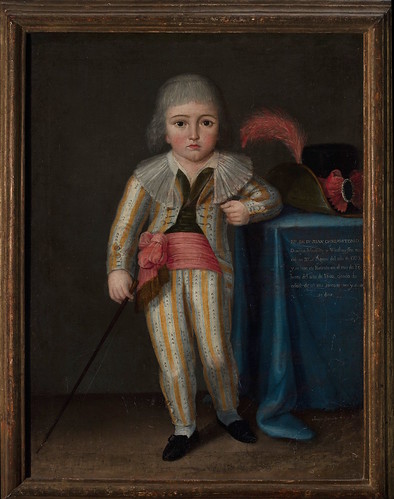
José María Vásquez (New Spain, active 1790-1822). Don Juan Crisóstomo Domingo Martínez, 1800. Oil on canvas, h. 38 in. (96 cm); w. 29 ½ in. (75 cm). Museo Nacional del Virreinato, 10-54120, Secretaría de Cultura, INAH, MX. Tepotzotlán, México. Photography by Francisco Kochen
The San Antonio 1718: Art from Viceregal Mexico is funded by Bexar County, the William and Salome Scanlan Foundation, Patsy Steves, and the Robert J. Kleberg and Helen Kleberg Foundation. The exhibit is also supported by the City of San Antonio’s Department of Arts and Culture.
San Antonio is one of the cities in Texas that attracts more tourists than any other. That said, visitors planning their next vacation should put this exhibition at the top of the list of places to see. Not only can visitors see artwork from San Antonio’s earliest settlers, but they can attend related lectures, too.
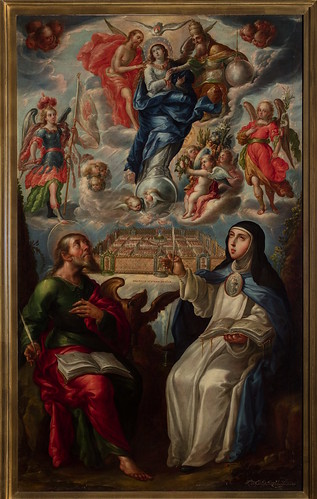
Cristóbal de Villapando (New Spain, 1645-1714). The Mystical City of God (La Ciudad mística de Dios), 1706. Oil on canvas, h. 71 in. (180 cm); w. 45 in. (114 cm). Museo de Guadalupe, 10-4996, Scretaría de Cultura, INAH, MX. Zacatecas, México. Photography by Francisco Kochen
The San Antonio Museum of Art is at 200 W. Jones Ave, just one mile from the San Antonio de Valero Mission known as the Alamo. Admission prices range from $8 to $15 with a special surcharge of $5 for this exhibition. Children 12 and younger and museum members are always admitted for free.
For more information call (210) 978-8100 or go to www.samuseum.org to see hours of operation. SAMA is closed on Mondays and major holidays. Admission is free of charge from 4 to 9 pm Tuesdays and 10 am to noon on Sundays.
Rosie Carbo is the Lifestyles Editor for Wandering Educators, and is a former newspaper reporter whose work has appeared in newspapers and magazines nationwide. Some of those publications include People magazine, The Dallas Morning News, The Houston Chronicle, and San Antonio Express-News. Some of her features were redistributed by The Associated Press early in her career as an award-winning Texas journalist.
